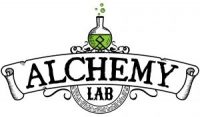Die Alchemie by Gottlieb Latz translated by Dennis William Hauck
Dr. Gottlieb Latz

This sample chapter is from SECRET OF THE EMERALD TABLET by Dr. Gottlieb Latz and translated by Dennis W. Hauck. The tablet material is taken from Latz’s million-word, monumental work DIE ALCHEMIE, published in Bonn, Germany in 1869.
“Hauck’s translation from the German is wonderfully fluid.” –First Impressions
Order from ETX Online Catalog
CHAPTER CONTENTS
The Ancient Science of Alchemy
The Three Titles of the Emerald Tablet
Dr. Gottlieb Latz was a German physician who spent much of his life deciphering the meaning of the Emerald Tablet. The tablet is a mysterious document whose origin has been traced back by some researchers over 3,500 years.
Allegedly a recipe for the Philosophers’ Stone, the tablet actually describes the true process behind Nature’s striving toward perfection, whether it be the evolution of the human soul or the transformation of base metals into gold.
Using the precepts he discovered in the tablet, Dr. Latz reconstructed a formula for the Elixir and claimed to have saved many of his patients from the incurable diseases of his time. He also rediscovered the Arcanum Experiment, the single laboratory experiment that openly demonstrates all the principles of alchemy.
This first English translation of Latz’ work presents the complete history of the Emerald Tablet, as well as the psychological, chemical, and philosophical interpretations of its meaning.
Secret of the Emerald Tablet
ISBN 1-55818-203-9
Contents
Translator’s Preface by Dennis William Hauck
Foreword by Dr. Gottlieb Latz
Chapter One: The Origin of the Emerald Tablet
Chapter Two: The Ancient Arcana Revealed
Chapter Three: First Revision: The Tabula Smaragdina
Chapter Four: Second Revision: The Tabula Hermetica
Chapter Five: Third Revision: The Tabula de Operatione Solis
Chapter 1: The Origin of the Emerald Tablet
The Ancient Science of Alchemy
Alchemy is the study of the Arcanum and how one can obtain it. The Arcanum, also known as the Elixir, Powder, or Stone, is the fundamental secret of nature. It is said to have the ability to perfect anything, to change baser metals into gold, to cure disease, to make man whole. The search for the Arcanum began in the darkest reaches of antiquity. Early alchemists called it Soma (the Body) in ancient Vedic texts and concealed its properties in a colorful variety of archetypal Gods. The Chinese called sought for it in the form of a Pill of Immortality. Later Indian alchemists referred to it as Rasayana. It was traced back to the first day of creation by Jewish alchemists. Greek philosophers saw it everywhere in nature, hidden in the composition of all matter. But it was the Egyptians who made finding it a science.
The ideas of alchemy were incorporated into all levels of Egyptian culture. It was their practical science as well as their religion. An Egyptian sage known as Hermes Trismegistus is said to have written thousands of books on alchemy and other topics. Although some of his works were kept in secret by priests, many of his manuscripts were lost when the great world library at Alexandria was burned by Muslims and Christians. Only about forty of his alleged works have survived. Nevertheless, he is said to authored the most important and revered document of alchemy, the Tabula Smaragdina or Emerald Tablet.
The Emerald Tablet is such an important document that the entire history of alchemy can be divided into the period before the discovery of the tablet and the period after. Alchemical thought centered on the interpretation of the tablet for over 2,000 years. This mysterious communication speaks directly to our inner understanding, and the readers throughout the ages have felt compelled to search for the deeper meaning of its precepts. The alchemists believed that the secrets of their art were buried in its enigmatic lines.
The origin of the Emerald Tablet has been traced as far back as the biblical Genesis, but most scholars attribute it to Hermes Trismegistus, whose name means “Thrice Greatest Hermes” or “Ruler of the Three Worlds.” In all probability, such a person really existed, but it is now impossible to separate the actual person from the legends that identify him with Thoth, the Egyptian god of learning and magic, the inventor of all numbers and science, and later the god of the Greeks, Hermes, who became the Roman god Mercury.
Albertus Magnus wrote that Alexander the Great discovered the tablet at the tomb of Hermes in Egypt. Wilhelm Kriegsmann has related a legend that Sarah, wife of Abraham, stumbled upon the tablet in a cave near Hebron and pried it loose from the stiff fingers of a mummified corpse. Other sources allege that Hermes was the son of Adam. He supposedly discovered the tablet in a cave while traveling in Ceylon. Some say it was discovered in an underground room of the pyramid of Cheops. Most stories describe the tablet as a green-colored stone with raised, bas-relief lettering in an alphabet that resembled Phoenician characters.
After extensive and painstaking research into the history of the Emerald Tablet, I discovered that a revised Greek translation of the original text was issued around 300 BC. This translation was performed by three groups of Alexandrian alchemists, who were attempting to use the mysterious tablet to unify conflicting Jewish, Greek, and Egyptian versions of alchemy. The mixing of cultures in Alexandria caused a shattering clash of dogmas that shook alchemy to its roots. But because these ideas were treated with such secrecy among the ruling classes, the masses (and history) took little note of the potentially catastrophic nature of the conflict. Even today, it is hard for us to imagine the shattering impact this crisis of interpretation had on the world. Alchemy was considered a gift direct from God and was the hidden foundation upon which the world’s religions and sciences were built. The truths of alchemy were a nation’s highest secrets and were revealed only to a small group of worthy priests and philosophers.
The enlightened tone of the Emerald Tablet so effectively defused this explosive situation, that it must have been divinely inspired. In fact, the translation of the tablet actually preserved the esoteric basis of Western Civilization. Although the rise of Christianity suppressed the Hermetic doctrines, they were passed on to later generations through a variety of occult groups and secret disciplines.
The Three Titles of the Emerald Tablet
The Emerald Tablet calls itself the “philosophy of the whole universe,” and this is perhaps its most fitting title. However, it was never the nature of alchemists to freely divulge the importance of their work, nor to offer the uninitiated such an obvious and tantalizing prize. The original version was probably named Tabula Smaragdina, because it was precisely what the Latin implies: a green-colored stone tablet. The first Greek translation and first revision probably went by that same name.
The second revision has been called the Tabula Hermetica. More fitting perhaps would be Tabula Aegyptia, owing to its origins. Most appropriate would be Tabula Khemica, a term which reflects the ancient name of Egypt (kheme = black soil of the Nile) and the roots of our own science of chemistry. The modern name of alchemy stems from the Arabic Al-Khemi, meaning “from Egypt” or “the Egyptian science.”
The third revision came to be known as the Tabula de Operatione Solis. This was a metaphysical interpretation that received wide acceptance and became the driving force behind alchemy through the sixteenth century. In the present work, the author will refer to the Emerald Tablet generally as the Tabula.
Unfortunately, the original Emerald Tablet has not survived or has been hidden away for safekeeping. As I noted, a few legends trace it as far back as Genesis, while other evidence suggests that it was written about 3000 BC, when the Phoenicians settled on the Syrian coast. The only complete modern text is a very early Latin translation, which exists in three versions. These three Latin versions correspond to the three Greek language revisions of a still older translation of the original Emerald Tablet. All three revisions were written in Alexandria, where Greek was the common tongue. Since neither the original translation nor the original document has survived, we have only the three revisions with which to work.
The history of Alexandria is usually divided into two periods. The first, from 332 BC to 30 BC, is the time of the Ptolemies and the great library. The city was founded by Alexander the Great as a center of Greek culture in Egypt. The harbor town quickly inherited the trade of the ancient Phoenician city of Tyre and even passed Carthage in size. The second period runs from 30 BC to 638 AD. The city became a part of the Roman Empire during the early part of this period, and then after 300 AD, it became a center of Christian learning. It was finally conquered by the Arabs around 640 AD.
For our purposes, it is convenient to divide the two Alexandrian Periods into three subdivisions, which correspond to the three revisions of the Emerald Tablet. The First Revision was written sometime between 300 BC and 270 BC, because it is based on ideas of the First Alexandrian School, which flourished at that time. The Egyptian and Hellenic cultures were involved in a fruitful merging, and this version reflects their worldview. This first version is centered on the three states of matter of Liquid, Solid, and Air. Fire was considered the agent of change between those states.
The Second Revision was probably written around 270 BC, because the Alexandrian Empirical School came into power at that time. Among other things, the Empiricists accepted Fire as a fourth state matter. By this time the city had also become a center of Semitic scholarship and a Greek version of the Old Testament was being translated there. Specific changes were made in the Second Revision of the Tabula that reflected the empirical Greek and Jewish biblical interpretations.
The Third Revision was probably conceived sometime in the period from 50 BC to 1 AD. This metaphysical evaluation suggested that non-physical processes were involved in the transformation of the states of matter and of the base metals into gold. It was this interpretation that allowed the rise of swindlers, puffers, and fakes, who called themselves alchemists. But it was also with this third interpretation that the ideas of alchemy finally took a form that could be understood by all men, regardless of culture or religion.
It should be mentioned that a fourth interpretation originated in Alexandria around 300 AD. It stemmed from the Neoplatonic School, which attempted to combine Greek philosophy with Arab mysticism and combine them with the moral doctrines of Judaism and Christianity. This rendering did not require another revision of the Tabula, but it was the first of many dozens of personal, philosophical, and even prophetic interpretations of the original three revisions.
With the Arab conquest of Egypt in the seventh century, Alexandrian alchemy was passed through Arabian sources — most notably the alchemist Geber (Jabir Hayyan). Eventually, knowledge of the art spread to Morocco, and by the eighth century alchemy had taken a strong hold in Spain. The three revisions of the Emerald Tablet found their way to Europe along this same path. For the next thousand years, alchemy was to flourish in the fertile soil of European thinkers.





